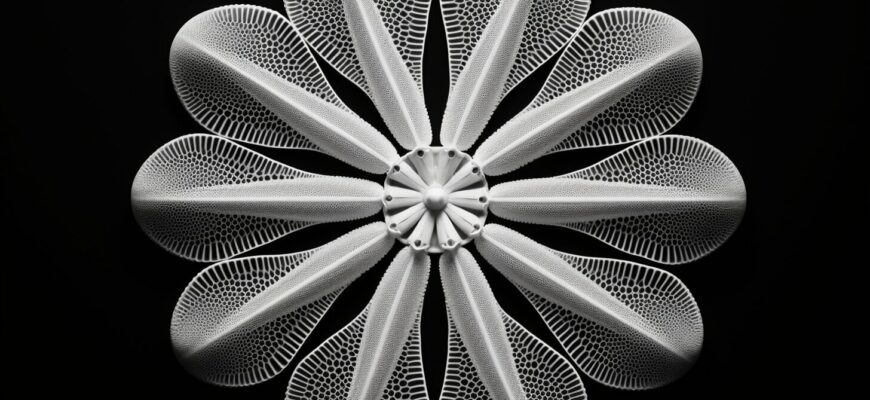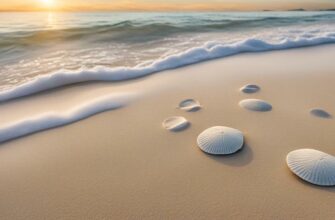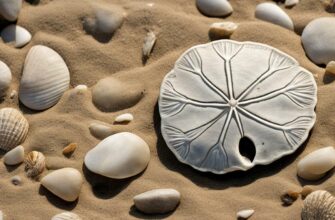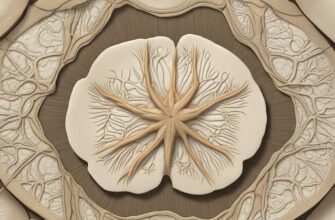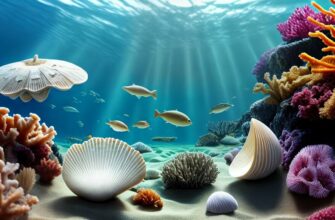Sand dollars are fascinating creatures that can be found on sandy ocean floors all around the world. While they may look like simple, flat discs, there’s so much more to these creatures than meets the eye. In this article, we’ll dive into the secrets that lie inside sand dollars and explore their unique anatomy.
- The Outer Shell: A Protective Layer
- The Keyhole: An Entrance to the Inner World
- The Skeletal System: A Marvel of Design
- The Internal Organs: A Complex Network
- The Digestive System
- The Water Vascular System
- The Reproductive System
- The Nervous System
- The Respiratory System
- Reproduction: The Circle of Life Continues
- Adaptations: Surviving in a Harsh Environment
- Frequently Asked Questions
- Are sand dollars alive?
- Can you find live sand dollars on the beach?
- Are sand dollars poisonous?
- What do sand dollars eat?
- How do sand dollars reproduce?
- Can sand dollars regenerate lost body parts?
The Outer Shell: A Protective Layer
When you pick up a sand dollar on the beach, the first thing you notice is its hard, flat shell. This shell is an essential part of the sand dollar’s anatomy, serving as a protective layer for the delicate structures inside.
The sand dollar’s shell is covered with tiny spines and pores that help it breathe and move. The texture and color of the shell can vary among different species of sand dollars, with some having smooth, white shells while others have rough, dark brown shells with intricate patterns.
The sand dollar’s shell is not just a passive shield, though. It also plays an important role in the creature’s survival. The underside of the shell contains a keyhole, which is the entrance and exit for water that the sand dollar needs for respiration and movement.
| Shell Characteristics | Function |
|---|---|
| Hard, flat, and round | Protects the sand dollar’s delicate structures inside |
| Covered with spines and pores | Helps the sand dollar breathe and move |
| Variation in texture, color, and pattern | Differentiates the sand dollar species and is useful in camouflage |
| Keyhole on the underside | Allows water to enter and exit for respiration and movement |
“The sand dollar’s shell is not just a passive shield, though. It also plays an important role in the creature’s survival.”
Without their protective shells, sand dollars would not be able to survive in their sandy habitats. The shells, with their beautiful patterns and intricate designs, also make them a favorite beachcombing find for many.
The Keyhole: An Entrance to the Inner World
You may have noticed a small, keyhole-shaped opening on the underside of a sand dollar. This opening is a crucial component of the creature’s anatomy, serving as both an entrance and exit for water and waste.
The keyhole is connected to the sand dollar’s water vascular system, a network of canals and tubes that allows the creature to move and perform other functions. Through this system, water is pumped into and out of the sand dollar’s body, creating the hydraulic pressure needed to operate the tube feet and perform other vital tasks.
The keyhole also plays a role in the sand dollar’s respiration and waste elimination. As water is pumped out through the keyhole, it takes with it any waste products generated by the creature’s internal organs. Oxygen is also taken in through the keyhole, providing the sand dollar with the necessary oxygen for survival.
The Skeletal System: A Marvel of Design
While the outer shell of a sand dollar may be what catches the eye, it is the intricate skeletal system that truly sets these creatures apart. Made up of a complex network of calcium carbonate structures, the sand dollar’s skeleton is a marvel of design.
At the center of the skeleton lies the madreporite, a small disc-shaped structure that serves as the entrance for water into the water vascular system. The water vascular system is a network of fluid-filled tubes that power the sand dollar’s tube feet, used for both locomotion and feeding.
| Ossicles | Radial Plates |
|---|---|
| The skeleton is made up of numerous small structures called ossicles, which fit together like puzzle pieces to form the intricate framework of the sand dollar. | The ossicles are connected by larger, more rigid structures called radial plates, which give the skeleton added stability and strength. |
The intricate design of the sand dollar’s skeleton is crucial to its survival. Not only does it provide the sand dollar with its distinctive flattened shape, but it also gives the creature the structural integrity it needs to withstand the pounding waves and shifting sands of its ocean habitat.
Next time you come across a sand dollar on the beach, take a closer look at its intricate skeletal system and marvel at the complexity of this fascinating creature.
The Internal Organs: A Complex Network
Inside a sand dollar, you’ll find a complex network of organs that work together to keep the creature alive and functioning. Let’s explore some of the key organs and their functions.
The Digestive System
The sand dollar’s digestive system is located in the center of its body. It consists of a mouth, esophagus, stomach, and intestine. The mouth is located on the bottom side of the sand dollar and is used to capture food particles, which are then transported to the stomach for digestion. The intestine absorbs nutrients from the food and eliminates waste.
The Water Vascular System
The water vascular system of a sand dollar is responsible for important functions such as movement, respiration, and feeding. It consists of a series of fluid-filled canals and tube feet that extend from the bottom of the sand dollar. The tube feet are used for moving along the sandy bottom and capturing food particles.
The Reproductive System
Sand dollars have separate sexes, and their reproductive organs are located in their body cavities. During mating season, eggs and sperm are released into the water, where fertilization occurs. The fertilized eggs develop into larvae and eventually settle on the ocean floor, where they develop into adult sand dollars.
The Nervous System
The nervous system of a sand dollar is not as complex as that of humans, but it is still an important part of the creature’s anatomy. It consists of a nerve ring around the mouth, which connects to radial nerves that run along the arms to the tube feet. The nervous system helps the sand dollar sense its surroundings and respond to changes in its environment.
The Respiratory System
Sand dollars do not have gills or lungs, but they are still able to breathe through their skin. Oxygen is absorbed into the body through small protrusions in the skin called papulae. Carbon dioxide is eliminated through the same process.
Overall, the internal organs of a sand dollar are a marvel of design and function. Working together, they allow this fascinating creature to survive and thrive in its sandy habitat.
Reproduction: The Circle of Life Continues
Sand dollars have a unique and fascinating way of reproducing that is essential to the survival of their species. The life cycle of a sand dollar involves several different stages, beginning with the release of eggs and sperm into the water.
During spawning season, which typically occurs in the spring and summer months, female sand dollars release their eggs into the water. These eggs are then fertilized by nearby male sand dollars, and the resulting larvae float in the water for several weeks before settling on the ocean floor.
Once the larvae have settled, they transform into juvenile sand dollars and begin their growth process. Sand dollars can take several years to reach maturity, and once they do, they are able to reproduce themselves.
Interestingly, sand dollars are able to change their sex over the course of their lifetime. When they first mature, they are typically males. As they get older, they may transition into females in order to reproduce more efficiently. This unique adaptation ensures that there are enough individuals of both sexes to sustain the population.
Overall, the life cycle of a sand dollar is a complex but fascinating process that allows these creatures to continue thriving in their sandy ocean habitats.
Adaptations: Surviving in a Harsh Environment
Sand dollars are fascinating creatures that have evolved unique adaptations to survive in their sandy habitats.
One of their most notable adaptations is their flattened shape, which enables them to burrow easily into the sand and avoid predators. Their tube feet, which are small extensions located on the bottom of their bodies, also play a role in burrowing and movement.
Another adaptation that aids in survival is their water vascular system, which powers their tube feet and helps with respiration. This system also plays a role in regulating their buoyancy, allowing them to maintain their position in the sand.
In addition to their physical adaptations, sand dollars have also developed behavioral adaptations. For example, they are known to aggregate in large groups in order to increase their chances of reproduction and survival.
Despite these adaptations, sand dollars still face challenges in their environment. One major threat is human activity, such as beach development and pollution, which can disrupt their habitat and cause harm to their delicate bodies.
Overall, the unique adaptations of sand dollars demonstrate the marvels of evolution and the incredible diversity of life on our planet.
Frequently Asked Questions
Sand dollars are fascinating creatures, but they can also be a source of confusion and mystery. Here are some common questions about sand dollars that we’ve answered for you:
Are sand dollars alive?
Yes, sand dollars are living creatures! While they may appear to be simple shells on the beach, they are actually echinoderms, a type of marine animal closely related to sea stars and sea urchins.
Can you find live sand dollars on the beach?
It’s possible to find live sand dollars on the beach, but it’s also important to know that they can only survive for short periods of time out of the water. If you do find a live sand dollar, it’s best to return it to the water immediately to increase its chances of survival.
Are sand dollars poisonous?
While sand dollars are not poisonous, it’s important to handle them with care. The spines on the underside of a sand dollar can be sharp and brittle, and they have been known to break off and cause injury to humans.
What do sand dollars eat?
Sand dollars are filter feeders that primarily eat tiny particles and plankton found in the water. They use their spines and tube feet to collect food and move it towards their mouth, which is located on the underside of their body.
How do sand dollars reproduce?
Sand dollars reproduce by releasing eggs and sperm into the water. Once fertilized, the eggs hatch into a free-swimming larval stage before eventually settling on the ocean floor and developing into adult sand dollars.
Can sand dollars regenerate lost body parts?
Yes, sand dollars have the ability to regenerate lost body parts, such as their spines and tube feet. However, the process can take several months and may not always be successful.
We hope these answers have helped you understand more about sand dollars! If you have any other questions or curiosities, feel free to reach out and ask.

